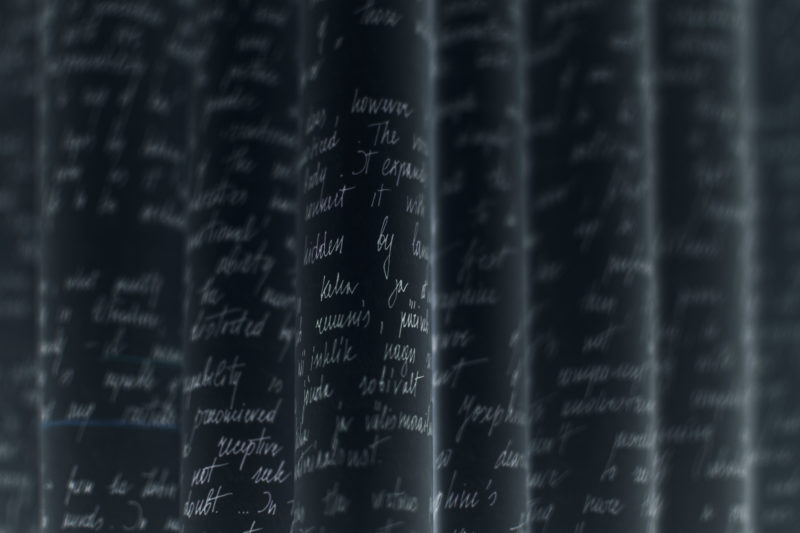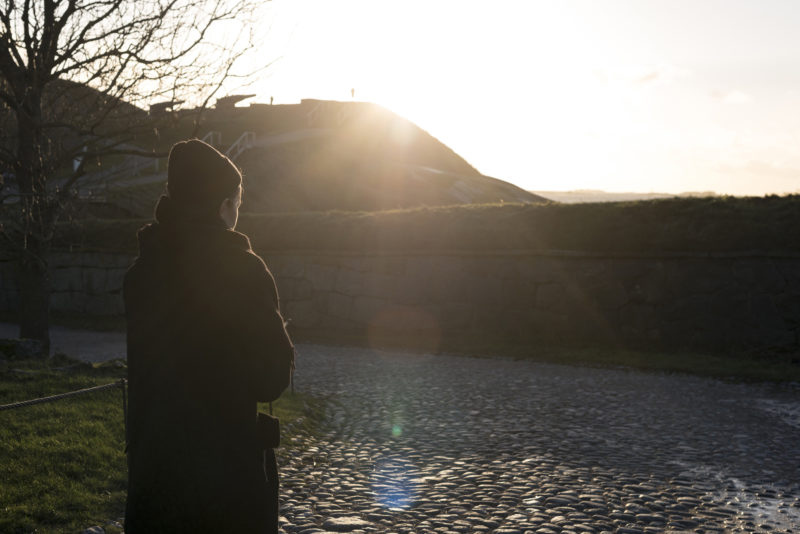4 Dec 2020
Interview
Anna Škodenko: solidarity, uncertainty, sensitivity
Anna Škodenko has been working in Helsinki since October 2020, first at Cable Factory and then Suomenlinna. The pandemic of this year has, of course, affected not only travel but the way we view the world. “I feel so privileged to be here,” Anna tells me. Travelling is restricted, so it really does make one appreciate the opportunities to focus on work, especially in a new place.
During her time at HIAP, Anna has been thinking about private and public spaces. She has walked a lot, and while walking, she has been contemplating solidarity and connected experiences. She describes feeling grounded; accepting of the situation, feeling peaceful and relaxed, and becoming more sensitive to spaces, places and feelings. The residency has made problems seem like they are far away somewhere else. At the same, however, Anna has felt connected to all humans: we all belong in the same place and experience common feelings of seclusion, loneliness, sadness and worry.
This feeling of uncertainty in a new place has made its way to Anna’s work while at HIAP, and she has focused on walking and singing, as well as reading, writing, and not making plans in advance.

Walking and singing during HIAP Open Studios days. Autumn 2020. Photo: Sheung Yiu @sheungyiuphoto / HIAP.
AA: Your work is characterised by contradictions: it is simultaneously lyrical and strong, romantic and cool, tragic yet playful. Which of these adjectives do you think best describes the way you are currently feeling?
AS: I always prefer to circulate around the contradiction itself. I like to balance on that line where every possible feeling is equally credible, trying to invent different ways how not to be involved in a game of choosing between “A” or “B”. It has nothing to do with neutrality, but rather “domestication” of some kind of antagonism.
Each statement is strongly bound with its antipode. Seen as such things gets beautifully fragile and and lead to unexpected dimensions.
On its own turn, it all brings me somewhere out of subjectivity/objectivity opposition: timeless boiling water, which has no hope to ever be settled down, resolved.

Unsourced constellation of quotes / research materials. Autumn 2020. HIAP.
AA: You often use texts as a starting place and respond to them, yet in your works you get a lot across without words. Do you feel that your art is born from reading and writing?
AA: You often use texts as a starting place and respond to them, yet in your works you get a lot across without words. Do you feel that your art is born from reading and writing?
AS: Text for me has a meaning of state in-between personal and communal. In the text one exists simultaneously in the inner and outer reality. Writing and reading are private activities. But text always has all the possible other readers and writers within itself. As if I can see traces of the other people’s eyes sliding along the lines.
It is an impossible community, of inner voices being shared in different volumes.
Some degree of a social landscape always finds its way into a work of art. For me this sociality rather comes in a form of texts I’ve read.
Every word in a text has somehow already happened, even if I write it myself. It was there: exposed and revealed before I’ve reached it. However, while reading I have sensation of a path-breaker. I like this bizarre déjà vu experience to enter my work.
AA: The references seem to go beyond literary towards linguistic. Are you interested in exploring the moment when a word becomes an image? Each word makes infinite images, in a way.
AS: Text is extremely visual. There is graphic appearance of the text and the images it creates in the imagination.
While preparing for the next work, as a rule I start to describe it with words. As if it already has happened. Mostly I write by hand. It has some particular magic… maybe it is like a spell, which makes things real. Well, and it all happens on the background of being sceptical in relation to precise meaning of every single word.
AA: How has your choice in materials evolved throughout the years? I understand you used to paint in previous years.
AS: My choice of materials changes more or less with every work I make. It does not evolve or develop in any particular direction. With every material/medium/technique there comes along a corresponding way of how I can observe the world around. It is a bit like changing personalities in response to the circumstances.
However, painting always remains here for me. Even just as an allegory. When I am actually painting, I want the liquid paint never to dry, retain its almost unlimited possibilities to become something other than it is.

Untitled [Thanks to H.C.Andersen…] A view from a periscope. 2017, Glasgow.
AA: Your current works researches the city in a playful manner. It almost gives the impression of the artist wanting to sneak around public spaces unnoticed. What kind of relationships have you formed with Helsinki and its inhabitants?
AS: Although Helsinki is located so close to the place where I live (Tallinn) and I have been here many-many times before for very different reasons, coming here now felt like an arrival to the other side of the world… as if I was suddenly disconnected from my memory and regular patterns of being abroad.
This resulted in me taking up (and maybe romanticising) a role of a stranger. I neither judge anything by comparing it to “home”, nor try to feel local. I try to stay in that undefinable, unrecognisable dimension. I terribly enjoy my daily walks in the city, being moved outside of affinity/dissimilarity games. Sometimes I feel as if I want to disappear on the streets of a city, being carried away by it.
I explored this sensation in depth during my recent work in Suomenlinna in the frame of the Open Studios week. I was walking around and singing on the island. I felt that I was occupying, filling the space with my voice, but at the same time being consumed by it. Sometimes, while walking and singing there, I even felt that kind of the thrill, that I “wished the earth to swallow me up”. At the same time this activity was providing me with a ground to walk on.
My singing activity changed significantly throughout the days I was doing it, through experiencing different reactions or their absence of the others and myself. I’ve started with humming a simple melody, and ended up with a song, which was composed and conditioned by the surroundings. It contained nonsensible lyrics in a “language” synthesised of the many I hear daily and a tune, instrumentalized by the sounds I have collected(recorded) form the island.
I did nothing completely unordinary, but it felt that I’ve reached an unknown territory. Maybe it has something to do with a sensation of getting lost. But instead of searching for a way out in a state of panic, I would rather keep the “orchestra” playing.
However, I have no intention to remain unnoticed. I am interested in the chance as such — when to be noticed or not have rather the same value.
I want the work to be discovered rather by an accident. Uncertainty of an accidental encounter brings along suspension in reaction. What to do with it? How to react? The viewer, by discovering the work, becomes its creator of it in a way.
In a way, the work is not finished when it is not presented in a definite manner. Without it the work is open, unresolved — and I need to establish an abnormal trust with the public space in order to let it “live” there.

Walking and singing during HIAP Open Studios days. Autumn 2020. Photo: Sheung Yiu @sheungyiuphoto / HIAP.
AA: The current year with all the challenges of a pandemic does seem to encourage work that is intimate and mostly happening outdoors. Was this a coincidence?
AS: Intimacy in experiencing artwork has had an important role in my art practice for as long as I can remember. Throughout the years I have tried to push it to different limits.
Today I think of it as of talking in a low-key voice, taking time, and allowing oneself to submerge to no matter how dusky areas. Gradually I’ve become more and more interested in how it will work in an environment not suitable for it by default. What can be learned about closeness in a space of multifaceted public dynamics?
Nowadays runaway into the outdoors has much of a taste of necessity. Meaning of going “outside” has started to change for me significantly. My home, hosting endless zoom meetings has an identity crisis in relation to its privacy. After all, maybe the main difference of an inner(private) and the outer(public) space lies in that very chances to get lost while observing the unfamiliar.
Photos provided by the artist.
Read more:
